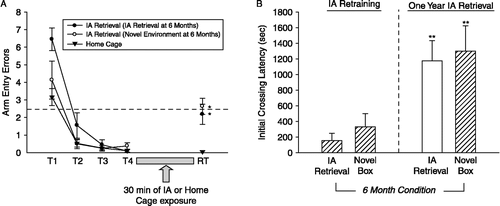Figures & data
Figure 1 Simplified timeline and procedures for Experiments 1–2. In Experiment 1, rats that were well-trained on the radial-arm water maze (RAWM) learned the within-day location of the hidden platform, which is illustrated by filled circle in the maze diagram (left side; ‘train’), followed by a 30-min delay period. Under control conditions, rats spent the 30 min delay in their home cages (not illustrated here), and under stress conditions rats were given inhibitory avoidance (IA) shock training, which is indicated by the dark box and lightning bolt. The 30-min delay period terminated with a memory retention test trial (see ‘Methods’ for additional details). One day later, the same rats were trained to learn a new location of the hidden platform, and then all rats were exposed to the IA apparatus without shock (as indicated by the X through the open lightning bolt), followed by the memory test. In Experiment 2a, the rats were first given IA training, and then 1 month later they were given RAWM training to learn the within-day location of the hidden platform, as described above. During the 30-min delay period between the RAWM learning and memory test phases, the rats were given an IA retrieval trial, in which they were placed in the IA apparatus, but no shock was delivered. In Experiment 2b, a subset of the rats from Experiment 2a were retested in the RAWM to learn a new hidden platform location, 6 months after IA training, with IA re-exposure during the 30-min delay period. In Experiment 2c, all rats were retested in the RAWM to learn a new hidden platform location, 12 months after IA training, with IA re-exposure during the 30-min delay period. The procedures for Experiment 3, which involved a control study of RAWM memory in unshocked rats placed in the bright side of the IA apparatus, are described in the ‘Results’ section.
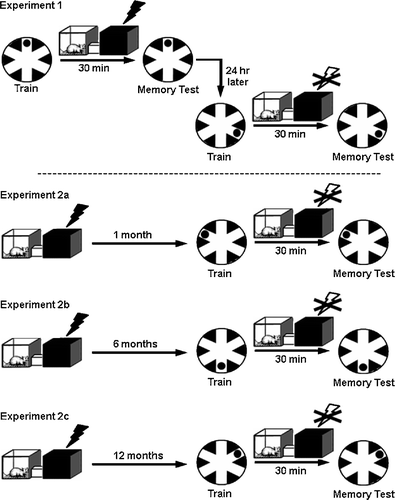
Figure 2 The effects of inhibitory avoidance (IA) training and 24-h IA retrieval on spatial working memory in the radial-arm water maze (RAWM). IA training during the 30-min delay period (A) impaired 30-min memory for the hidden platform location. Twenty-four hours later, re-exposure of the rats to the IA apparatus (without shock) resulted in an increase in arm entry errors on the 30-min retention trial (B). The RAWM data are presented as mean number of arm entry errors ( ± SEM) committed per trial. As indicated in (C), rats that were exposed to IA training on day 1 exhibited significantly greater mean initial crossing latencies on day 2 than rats that were exposed to the IA apparatus, without footshock, on day 1. This indicates that the trained rats had a powerful avoidance memory for the dark chamber of the IA apparatus. The sample sizes were: IA–shock (n = 10) and IA–no shock (n = 10). * p < 0.05 compared to the IA–no shock group; ** p < 0.05 compared to all other groups. In all water maze figures, the dashed line at 2.5 errors indicates chance level of performance (Diamond et al. Citation1999). The 2.5 error chance level reflects performance by rats following an optimal search behavior in which a rat searches for the platform without re-entering the same (incorrect) arm within a trial. However, when rats perseverated (repeatedly entered incorrect arms), they could perform at levels worst than chance. Perseveration typically occurred only on the first trial of the day, which is why performance was worse than chance on trial 1, but not on other trials. Rats with damage to their hippocampus exhibited chance level of performance on every trial (Diamond et al. Citation1999).
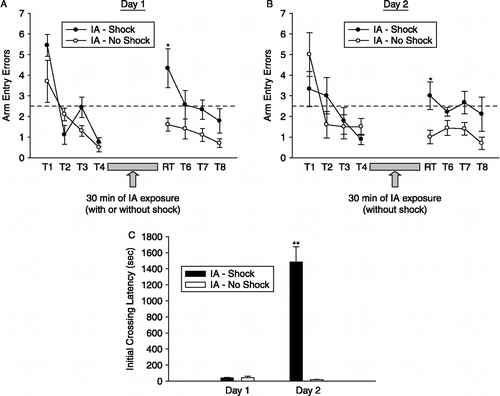
Figure 3 Re-exposure to the inhibitory avoidance (IA) apparatus 1 month after IA training impaired 30-min memory for the hidden platform location (A). Rats exposed to IA retrieval also took longer to relearn the location of the hidden platform after the 30-min delay period, as indicated by significantly more arm entry errors in this group on trial 6 (T6). (B) The mean initial crossing latencies (ICLs) during IA training, 24-h IA retrieval, and the two 1-month IA retrieval sessions during the 30-min delay period in radial-arm water maze (RAWM) training. The mean ICLs during the 24-h and 1-month retrieval trials were significantly greater than those displayed during IA training. The mean ICL on day 2 of water maze training was significantly lower than the ICL during the initial 24-h retrieval trial, 1 month earlier. The sample sizes were: IA retrieval (n = 16) and home cage (n = 16). * p < 0.05 compared to the Home Cage group; ** p < 0.05 compared to IA Training, β = p < 0.05 compared to IA Retrieval RAWM (day 2).
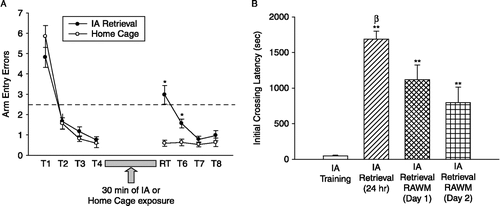
Figure 4 The effects of inhibitory avoidance (IA) retrieval, 6 months following IA training, on 30-min spatial working memory in the radial-arm water maze (RAWM). Re-exposure to the IA apparatus, without shock 6 months after IA training impaired memory for the hidden platform location (A). Exposure to a novel environment during the 30-min delay period had no effect on spatial memory. As illustrated (B), rats given IA ‘re’-training displayed significantly greater mean initial crossing latencies during the 6-month retrieval trial than those displayed during the retraining session. The sample sizes were: IA retrieval (n = 8), novel environment (n = 8) and home cage (n = 16). For the IA data, the sample sizes were * p < 0.05 compared to all other groups; β = p < 0.05 compared to the home cage group; ** p < 0.001 compared to retraining.
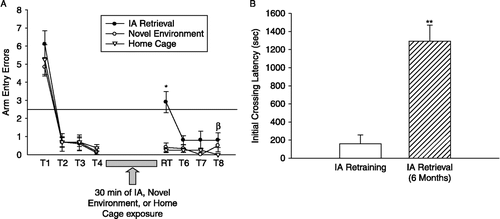
Figure 5 IA retrieval, 1 year following IA training, impaired 30-min spatial memory, independent of the manipulation rats received 6 months earlier (A). The rats demonstrated a significantly greater mean initial crossing latency during the 1-year IA retrieval trial than during IA retraining, independent of whether or not they had been given a retrieval trial 6 months earlier (B). The sample sizes were: IA Retrieval (IA retrieval at 6 months' n = 8), IA retrieval (novel environment at 6 months; n = 8) and home cage (n = 16). * p < 0.05 compared to the home cage group; ** p < 0.05 compared to both IA retraining groups.
